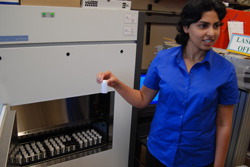Researchers Monitoring Radioactive Levels from Scripps Pier
Seven years of data provide baseline for potential impact of Japan nuclear crisis
Ioana Patringenaru | March 21, 2011

Antra Priyadarshi, a postdoc in the lab of Mark Thiemens, dean of Physical Sciences, shows an aerosol sample Thiemens' team uses to monitor radioactivity.
If any small, harmless amounts of radiation from Japan’s troubled nuclear reactors reach the UC San Diego campus, Mark Thiemens, dean of the Physical Sciences Division, and the researchers in his lab will be the first to know.
Thiemens and his team operate a device that uses sulfur to measure radioactivity in the environment. Like many fellow scientists, President Barack Obama and several U.S. government agencies, Thiemens stresses that harmful radiation will not reach the West Coast. He said he doubts whether the radiation will even be detectable.
“It’s a long way from here to there,” he said. “I don’t think we’ll see anything.”
Thiemens pointed out that even at Chernobyl, the worst effects of the radiation were felt in about a 1,000-mile ratio. San Diego is roughly 5,500 miles from the Japanese coast. The radiation and radioactive particles generated at the Fukushima reactor are akin to green water in a bottle. Dump that water in the ocean and see how long it takes before you can still see the green in all that blue, Thiemens said.
The ocean, more specifically the Scripps Pier, is where Thiemens’ team collects air samples that they analyze, looking for radioactivity in the lab. The samples are captured on a surface akin to filter paper then mixed with gel in vials. The vials are placed in a device for 12 hours, which then records the amount of electrons they emit per minute.
The postdoc researcher who has been operating the device for two years, Antra Priyadarshi, studied at the Tokyo Institute of Technology before coming to UCSD. She has been following the situation in Japan closely and has been in touch with several of her former colleagues. All of them are very concerned about the situation at the nuclear plant in Fukushima, she said.
The airflow from Japan to the West Coast works something like this: air is lofted in Asia, then injected into the jet stream, said Tim Bertram, a professor of chemistry and biochemistry at UCSD. It then takes these particles about seven days to reach the West Coast. During that time, they disperse and mix with other air particles, Bertram said. They then have to enter the surface level of air here, a process during which they get mixed further and dispersed. By the time they could get back down to the surface, particles would be very significantly diluted, he said.
Sure, researchers can detect the signatures of dust storms in China and Asian pollution on the West Coast, Bertram said. But by the time they reach these shores, they are very well mixed. They’re also much easier to detect at higher altitudes. Bertram added that he hasn’t seem any anomalous readings so far.
“If it’s hard to detect in Tokyo, it’s hard to imagine that we’ll be detecting it here,” he said.

|